Contents
What is Transposition?
Transposition is the process of shifting genetic sequences from one site in a genome to another.
- In genetics, transposition refers to the removal and transfer of a DNA segment from one location on the same or a different chromosome to another.
- It differs from the transmission of genes from parents to offspring via reproductive methods including sexual and asexual reproduction (vertical gene transfer).
- In transposition, genes are transferred from one organism to another via a process of duplication and insertion.
- Certain bacteria’s antibiotic resistance and virulence transmission are due to transposition.
- The DNA fragment linked with transposition is referred to as a transposon or jumping gene.
- A transposable element, or transposon, transfers from one DNA location to another during transposition.
- In the 1940s, Barbara McClintock discovered transposons while studying the genetics of maize. Transposons have since been discovered in all types of species, from bacteria to humans. We’ll start by discussing bacterial transposons.
Types and Mechanisms of Transposition
- Transposons are commonly referred to as “jumping genes” because of their capacity to jump from one location to another.
- However, the word is rather deceptive as it indicates that DNA always leaves one location and moves to another.
- This type of transposition is known as nonreplicative transposition or “cut and paste” because both strands of the original DNA transfer from one location to another without reproducing.
- Nevertheless, transposition typically involves DNA replication, so one copy of the transposon remains at its original location while another copy inserts at the new location. This is known as replicative transposition (or “copy and paste”) because a transposon that moves along this route repeats itself.
- Consequently, there are two forms of Transposition, including:
- nonreplicative transposition (or “cut and paste”)
- replicative transposition (or “copy and paste”)
1. Replicative Transposition
- When a transposon replicates, making a new copy while leaving the old copy behind, it is referred to as a replicative transposon, however when transposons travel from one location to another, leaving a gap behind, they are referred to as non-replicative transposons.
- Simply said, replicative and non-replicative transposition are also referred to as copy-and-paste and cut-and-paste transposition, respectively.
Replicative transposition of DNA transposons
The DNA transposon strand transfer process is described in the following section.
Step 1
- At the start of the process, the transposase enzyme comes together at both ends of the transposable element.
- This part moves the whole transposon to a different place.
- This assembly makes the actual transposon. It helps cut the transposon in one place and put it in another place. This is called a “cleaving and joining reaction.”
Step 2
- The transposase protein speeds up the process in the second step. The transposase protein cuts the DNA at the two ends of the TE, making the 3′ OH ends free.
- Also, it makes a space in the target DNA sequences where the transposon will go.
- The transposase proteins cut both the ends of the transposon and the DNA of the host cell. In total, it makes 4 nicks, two at each end of the transposon and two in the DNA of the target.
- The process of nicking in transposons is called “sequence-specific nicking.” The two nicks made on both ends of the transposons have the same sequences because they are inverted terminal repeats.
- The important thing that happens here is that the transposase makes both ends of the transposon terminus have a free 3′ end.
- These 3′ ends are very important for a polymerase to make DNA, which means that the gaps will be filled and new transposons will be made. But with the cut-and-paste method, the nick stays as well.
Step 3
- In this step, the strand transfer mechanism makes a DNA molecule with two branches.
- In this step, the 3′ end made in the last step is joined to the 5′ ends of either the host DNA or the target DNA. The connection between them is covalent, but the 5′ ends of the transposon sequence stay attached to the old DNA.
- The third step of the transposition mechanism that moves the replication strand.
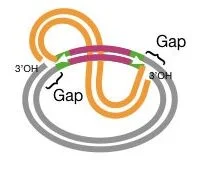
Step 4
- In the subsequent phase, the intermediate strand transfer complex generates two replication forks that allow for regular DNA replication. The 3′ end of the target DNA is cleaved to allow a primer for replication.
- The replication machinery of the host cell, which is built at the replication fork junction, the 3′ free end, serves as a primer, and replication proceeds from end to end.
Step 5
- In the final phase, at the conclusion of the replication, two DNA molecules containing the transposon are produced. The duplication of the short direct target site flanks the transposon.
- These target site duplications will migrate with the transposons to a new place, where they will be inserted.
- Notably, frequent deletions and duplications that occur throughout the replicative transposition mechanism process are its most significant drawback.
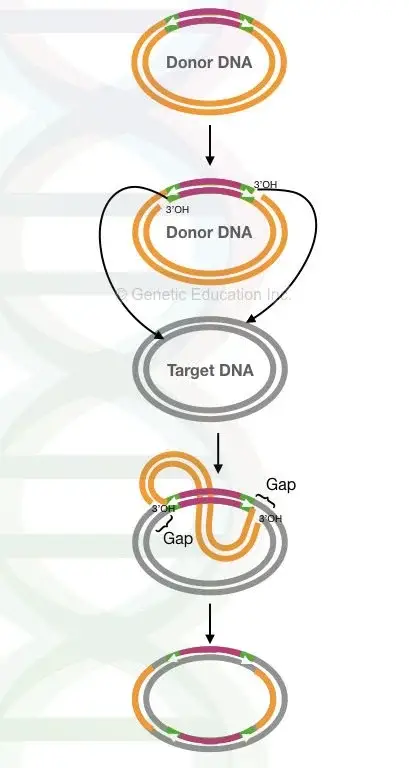
- Through the cointegrate structure, replicative transposition happened in plasmid DNA.
- The replicative transposition begins with the fusion of donor and recipient plasmids. Through transposase-mediated catalytic activity, it produces a structure known as “co-integrates.”
- In the cointegrate structure, the transposon replicates and generates a second molecule of itself in the same direction. In the subsequent step of the procedure, recombination occurs between both transposons. At the “res” location, transposon and resolvase govern the process.
- Another bacterial protein that inhibits the transposition process is resolvase. The two molecules are then separated, and two plasmids containing two transposons are created.
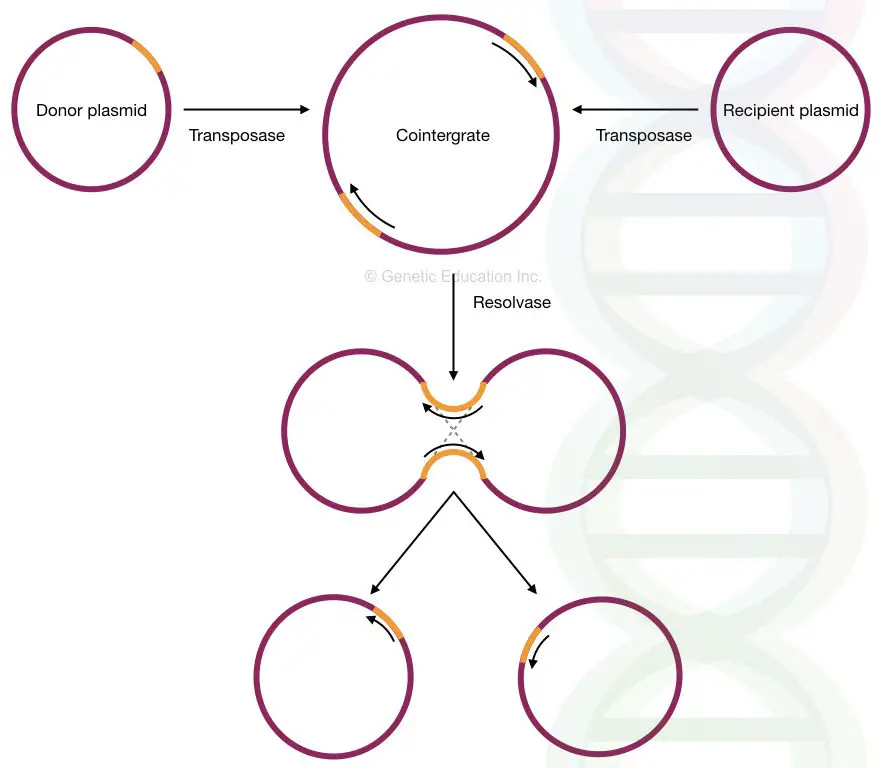
Replicative transposition of Retrotransposon
- The retrotransposons also utilise the transposition mechanism of replicative strand transfer.
- In place of direct replication, reverse transcription here mediates DNA transposition via an RNA intermediary.
- In the very first stage, RNA is synthesised from the DNA of the retrovirus or retrovirus-like particle by the mechanism of transcription using the cellular RNA polymerase.
- As was previously known, the long terminal repeats of transposons do not code for any protein and also contain a promoter region.
- The transcriptional apparatus generates the full-length RNA molecule from the LTR. By way of the reverse transcription method, DNA is synthesised from RNA.
- Here, there is no copy of the cDNA, or complementary DNA, created by the process at the prior position.
- In the subsequent stage, recombination occurs when the cDNA recognises the integrase protein. Once cDNA recognises the integrase, it is assembled on both ends of the DNA.
- Similarly to the strand transfer mechanism of DNA transposition, the integrase creates a gap at the 3′ end of each strand of DNA by removing certain nucleotides from this end.
- Using the mechanism of DNA strand transfer, integrase catalyses the insertion of changed DNA into the DNA of the host genome.
- The process of recombination is complete once the DNA repair mechanism fills the gaps with a DNA repair enzyme.
- After recombination is complete, the target site duplication is formed on both ends of a new transposon, probably because the DNA repair mechanism on both sides is identical.
- This is the entire replicative transposition process for DNA transposons and retrotransposons.
- TY element in yeast and Copia element in Drosophila follow the replicative mechanism for transposition, whereas Tn3, Tn5, and phage Mu do not.
Replicative Transposition of Tn3

- Figure shows the structure of Tn3, which shows one well-studied way that transposition works.
- Along with the bla gene, which codes for ampicillin-inactivating b-lactamase, Tn3 has two other genes that help with transposition.
- Tn3 moves DNA in two steps, and each step needs a different product from the Tn3 gene.
- Figure 23.5 is a simplified version of the order of things that happened. We start with the donor, which contains Tn3, and the target.
First Step
- In the first step, the two plasmids join together through Tn3 replication to make a cointegrate. This is a piece of DNA that links the two plasmids together.
- This step needs the two plasmids to join together again, which is done by the tnpA gene product from the Tn3 transposase gene.
- Figure 23.6 shows in detail how the four DNA strands that are involved in transposition could work together to make the cointegrate.
- Figures 23.5 and 23.6 show transposition between two plasmids, but the donor and target DNA can also be phage DNA or the bacterial chromosome itself.

Second Step
- The second step in Tn3 transposition is the separation of the cointegrate into two separate plasmids, each of which has one copy of Tn3.
- This step is a recombination between res sites on Tn3 that is triggered by the product of the resolvase gene, tnpR. Tn3 transposition is a two-step process, as shown by several lines of evidence.
- First, mutants in the tnpR gene can’t get rid of cointegrations, so they cause cointegrations to form as the end result of transposition.
- This shows that the cointegrate is usually a part of the reaction that happens in the middle.
- Second, even if the tnpR gene is broken, cointegration can be fixed if another DNA molecule, like the host chromosome or another plasmid, has a working tnpR gene.
2. Conservative or Nonreplicative transposition (or “cut and paste”)
- Some transposons, like Tn10, move without copying themselves. They leave the donor DNA and show up in the target DNA. Why does this happen?
- It’s possible that nonreplicative transposition begins the same way as replicative transposition, by cutting and joining DNA strands from the donor and the target, but then something different happens.
- Instead of replication happening through the transposon, new nicks show up on both sides of the transposon in the donor DNA.
- This frees the donor DNA that had a gap in it, but the transposon is still attached to the target DNA.
- The remaining nicks in the target DNA can be sealed, making recombinant DNA with the transposon integrated into the target DNA.
- The donor DNA has a gap between its two strands, so it could be lost or, in this case, the gap could be fixed.

About the above Image
Step 1: involves nicking the two plasmids to create the free ends labelled a-h.
Step 2: Join the ends a and f, as well as g and d. This frees up b, c, e, and h.
Step 3: Two of the remaining free ends (b and c) function as primers for DNA replication, as depicted by the enlargement of the replicating area in Step 3.
Step 4: Continue replicating until the ends of b and c reach e and h, respectively. These ends are ligated in order to finish the cointegrate. Observe that the entire transposon has been duplicated (blue). The paired res sites (purple) are presented for the first time, despite the existence of a single res site in prior rounds. The cointegrate is depicted with a loop so that its derivation from the preceding figure is more apparent; however, if the loop were removed, the cointegrate would resemble the one in Figure 1. (shown here at right).
Step Five and six (resolution): A crossover occurs between the two res sites in the two copies of the transposon, resulting in the formation of two separate plasmids, each of which contains a copy of the transposon.
Mechanism of Nonreplicative transposition
- The first two steps are identical to those of replicative transposition, and the top structure is identical to that between steps two and three in Figure.
- However, subsequent nicks appear at the locations indicated by the arrows.
- This releases the donor plasmid without the transposon, which remains bound to the target DNA.
- Filling in gaps and closing nicks completes the target plasmid’s new transposon by securing it in place.
- The donor plasmid’s free ends may or may not connect. In any case, the transposon has been removed from this plasmid.

3. Retro-transposons
- Retro-transposons are transposons whose RNA is reverse-transcribed into DNA by the reverse transcriptase enzyme, and whose newly synthesised DNA is placed into a new location on a chromosome.
- This type of transposition is referred to as retro-transposition.
- Some of these retro-transposons are connected to retro viruses and utilise their reverse transcriptase enzyme for transposition; these transposable elements are referred to as retroposons.
- Only Eukaryotic organisms possess retro-transposons.
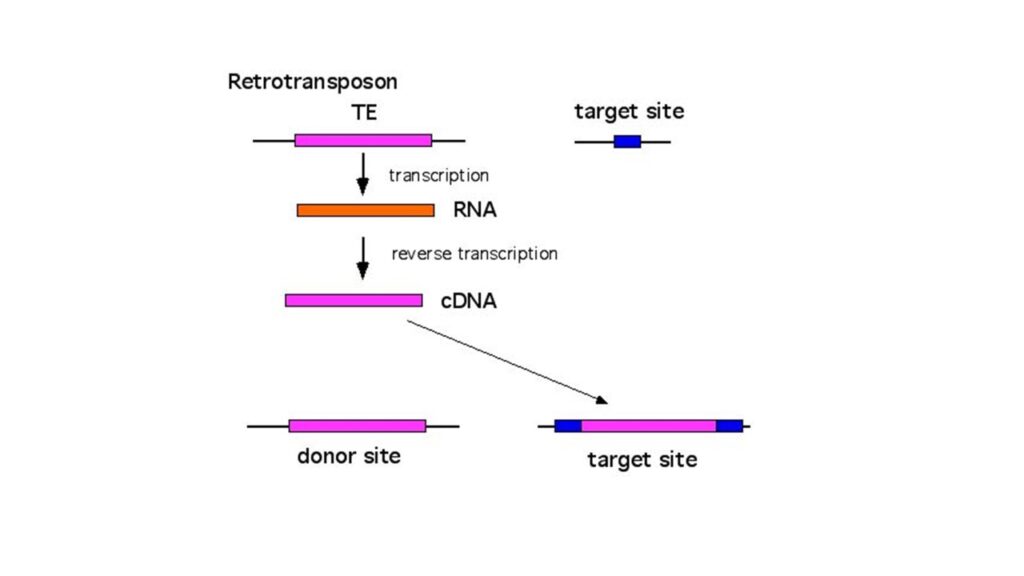
Insertion Sequences: The Simplest Bacterial Transposons
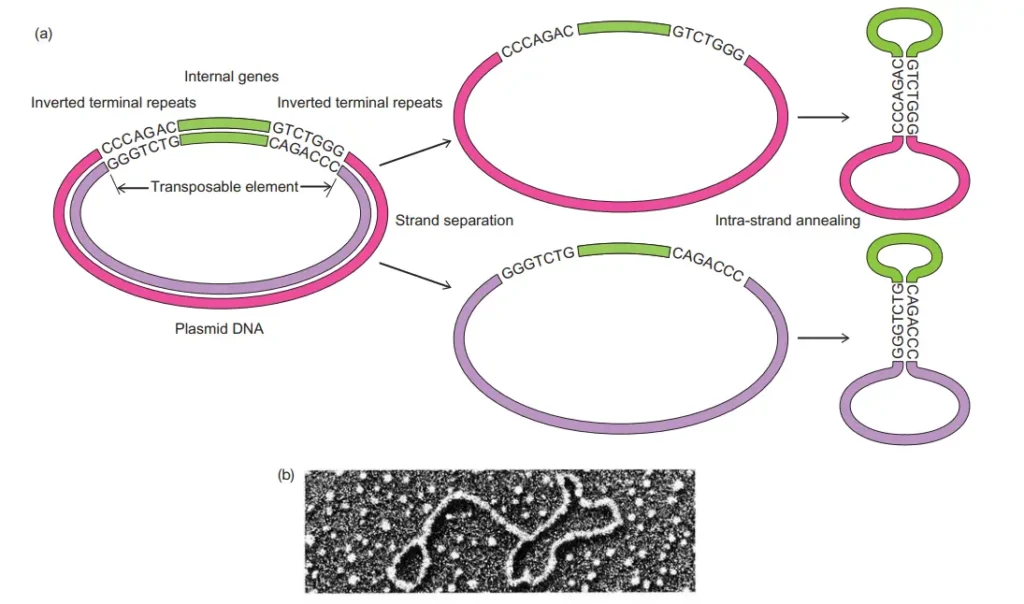
- Only the parts that are needed for transposition are in bacterial insertion sequences. The first of these is a set of special sequences at the ends of a transposon. One of these sequences is an inverted copy of the other.
- The second part is the group of genes that tell the body how to make the enzymes that make transposition happen. Because the ends of an insertion sequence are inverted repeats, if one end is 59-ACCGTAG, the other end of that strand will be CTACGGT-39, which is the reverse complement.
- The examples of inverted repeats given here are made up to show how the point works.
- Most insertion sequences have inverted repeats that are between 15 and 25 bp long.
- IS1 has inverted repeats that are 23 bp long. Inverted repeats can be hundreds of base pairs long in transposons with a lot of DNA.
- With the experiment, Stanley Cohen showed how inverted repeats at the ends of a transposon can be seen.
- Figure 23.1a shows that he began with a plasmid that had a transposon with the structure on the left.
- The ends of the transposon, which were backwards copies of the original plasmid, were connected to the original plasmid.
- Cohen thought that if the transposon really did have inverted repeats at its ends, he could separate the two strands of the recombinant plasmid and get the inverted repeats on one strand to base-pair with each other to make a stem-loop structure.
- The two inverted repeats would make up double-stranded DNA for the stems, while the rest of the DNA would be in single-stranded form for the loops.
- The stem-loop structure can be seen in the electron micrograph in Figure 23.1b. The main part of an insertion sequence tells the computer how to make at least two proteins that speed up the transposition process.
- We know that these proteins are needed for transposition because mutations in the body of an insertion sequence can stop that transposon from moving.
- One more thing that an insertion sequence has in common with more complex transposons is that it is right next to the transposon.
- There are two short direct repeats in the DNA right next to the transposon. These repeats didn’t exist before the transposon was put in; they are a result of the process of putting the transposon in and tell us that the transposase cuts the target DNA in a way that isn’t two cuts right next to each other.
- The distance between the two cuts in the target DNA strands determines how long these direct repeats are. This distance, in turn, depends on how the insertion sequence is made.
- IS1’s transposase makes cuts that are 9 base pairs apart. This makes direct repeats that are also 9 base pairs long.

References
- Mechanisms of DNA Transposition. (n.d.). Mobile DNA III, 531–553. doi:10.1128/microbiolspec.mdna3-0034-2014
- Bourque, G., Burns, K.H., Gehring, M. et al. Ten things you should know about transposable elements. Genome Biol 19, 199 (2018). https://doi.org/10.1186/s13059-018-1577-z
- Muñoz-López M, García-Pérez JL. DNA transposons: nature and applications in genomics. Curr Genomics. 2010 Apr;11(2):115-28. doi: 10.2174/138920210790886871. PMID: 20885819; PMCID: PMC2874221.
- https://www.onlinebiologynotes.com/transposable-elements-characteristics-and-mechanisms-of-transposition/
- https://www.edx.org/course/molecular-biology-part-2-transcription-and-transposition
- http://what-when-how.com/molecular-biology/transposition-molecular-biology/
- https://pdb101.rcsb.org/motm/84
- https://www.annualreviews.org/doi/abs/10.1146/annurev.cb.06.110190.001501?journalCode=cellbio.1
- https://www.slideshare.net/vivekaiden/transposones
- https://www.ibiology.org/genetics-and-gene-regulation/transposable-elements/
- http://www.bio.brandeis.edu/classes/biol122a/Transposition.htm
- https://www.notesonzoology.com/plants/transposable-elements-in-different-plants-biology/5342
- https://www.classcentral.com/course/edx-molecular-biology-part-2-transcription-and-transposition-4072
- https://journals.asm.org/doi/full/10.1128/microbiolspec.MDNA3-0034-2014
- https://www.biologyonline.com/dictionary/transposition
- 9. Transposition of DNA. (2021, July 20). The Pennsylvania State University. https://bio.libretexts.org/@go/page/364
- http://www.sci.sdsu.edu/~smaloy/MicrobialGenetics/problems/transposons/transposition/
- https://en.wikipedia.org/wiki/Transposable_element
- https://www.biologydiscussion.com/genetics/transposition-meaning-and-mechanism-genetics/65170
- https://www.nature.com/scitable/topicpage/transposons-the-jumping-genes-518/
- https://www.sciencedirect.com/topics/biochemistry-genetics-and-molecular-biology/dna-transposition
- https://geneticeducation.co.in/replicative-transposition-of-dna-transposons-and-retrotransposons/
- https://en.wikipedia.org/wiki/Transposition
- https://viralzone.expasy.org/4017











